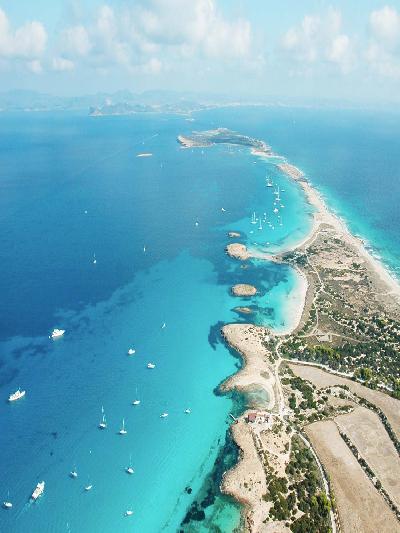
The islands of Ibiza and Formentera are part of the Pitiusas, but they are better known as the southernmost islands of the Balearic archipelago (Spain), which is located in the western Mediterranean Sea; the third and fourth largest islands, respectively. The sea separated the Balearic Islands from the continent 5 million years ago, when the mountain chain that connected Gibraltar and Morocco, which served as a kind of natural dam between the Atlantic and the then Mediterranean Sea, so that it later failed and exploded.
The Balearic Islands, therefore, are nothing more than the mountain peaks, whose foothills originate in the extreme south of continental Spain, near the city of Valencia. The mountains are mainly composed of red sandstone, limestone and basalt. The island of Formentera is only 17.7 kilometers south of Ibiza and it only takes a few minutes to reach its emerald waters and its unique beaches by ferry.
Ibiza has an area of approximately 574 square kilometers and is about 40 km long and 14 km wide. Little Formentera is only 83.2 square kilometers.
Formentera, Spain, is a part of the Pitiusas Islands, located in the Mediterranean Sea. It is the quietest and smallest piece of land, very popular with tourists for the abundance of recreational areas and picturesque nature. Despite its small size, Formentera is visited by more than 50,000 tourists a year in Spain, although the island's population is less than 12,000 people.
The island of Formentera is the smallest and most picturesque of the Balearic Islands. It only has one city - San Francisco de Formentera, and the western and southern parts of the island are almost intact from civilization.
The name of the island comes from the Spanish word "frumentum", literally translated as "grain of wheat". This unusual name can be explained by the fact that the island was originally intended to be completely sown with rye and wheat, but due to the poverty of the soil and the large number of rocks, this was not possible.
In total, on the island of Formentera, in Spain, there are more than 30 beaches, and all have similar characteristics: golden sand, clean sea, underdeveloped infrastructure and a fairly large number of tourists.
In total, on the island of Formentera, in Spain, there are more than 30 beaches, and all have similar characteristics: golden sand, clean sea, underdeveloped infrastructure and a fairly large number of tourists.
There are just over 20 hotels in Formentera, which are very popular with tourists. You must book the accommodation 5-6 months before your trip, as the rooms are rented very quickly.
Most hotels are located in cities close to popular recreation areas. It is worth bearing in mind that there are no hotels in some parts of Formentera. Accommodation prices are high, it is unlikely that you can find a cheap room.
The main means of transport on the island are mopeds, which can be rented almost anywhere in Formentera. Cars are not particularly popular - it is too expensive and not so convenient.
Public transport is poorly developed - there are several bus routes, which run 7-8 times a day. They are only accessible to the main tourist centers of the island.
Since there is no airport on the island, the only way to get to Formentera is by ferry from Spain. The easiest way to get here is from Ibiza (Ibiza airport has regular flights from many European countries and Russia) - the world famous resort and Formentera is only 28 km away, which can be reached in 45-50 minutes .
If you travel by car, this option is also suitable, you have to pay 35-40 euros for car transport by ferry.
The island of Formentera is one of the few tourist centers in Spain, which was not entirely built by hotels, and managed to preserve its picturesque nature.
